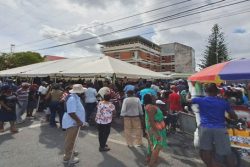Dear Editor,
When my father was a poor young man living in rented accommodation, he applied for a house lot. He was invited to put his hand in a hat, and pulled out a piece of paper with a number on it. That number represented the house lot at Castello Housing Scheme which he then received under the housing programme of the Burnham administration. By putting the lot numbers into a hat and passing the hat around, the Housing Authority of the day put it beyond all doubt that the allocation of the house lots was made on a random basis. My father was pleased that his lot faced the east where the breeze comes from.
The defining policy of the current administration has been its housing policy. The policy has been more far reaching and successful than that of the previous administration. In the 1990s the Eccles, East Bank area was converted for housing, and a Venezuelan initiative resulted in the construction of a scheme at Enterprise on the East Coast. Since then, the Central Housing and Planning Authority has managed housing schemes throughout the coastal area, from Tuschen to Enmore in the Demerara alone.
The housing drive has also had positive indirect financial effects for the country. Banking has thrived with thousands of new mortgages, and more money has circulated in the system. The construction industry grew enormously, and provided employment for thousands in Guyana. Hardware stores flourished. And our standard of living improved. For the average person, there is no achievement to compare with the acquisition of your own house.
Of course, real estate is valuable, and the cost of building infrastructure (roads, electricity, water, drains) on land is high. In 2013, $3.1billion was budgeted for the CHPA out of the taxpayers’ coffers. The Authority developing the land and allocating house lots to citizens must implement carefully designed and monitored systems to ensure that there is no abuse, no favouritism for friends, no mismanagement of money, no bribes for house lots. There must be accountability to the voters/taxpayers.
In the 1990s, the CHPA had adopted a number of criteria for eligibility for house lots. Preference was given to families rather than single applicants. Young people had a better chance than older folk.
The applicant had to demonstrate that he genuinely needed the house lot for his own residence, and, in order to avoid the possibility of abuse by profiteering, recipients of house lots were precluded from selling or leasing for ten years. They could not buy cheap and sell at a profit. Most importantly, an applicant for a house lot must not already own property and must not have previously owned property (no transporting your house into your son’s name so you can be eligible for a CHPA house lot). After all, a CHPA housing project is to benefit people in need, not to give rich people more wealth.
It is not clear whether these rules continue in effect. The perception is that they apply to some citizens but not to all. The allocation of land by the CHPA to those close to the government has been the source of much criticism and speculation.
There is no doubt that many recipients already owned property at the time they benefited from the largesse of the state, or had previously owned property and sold the same. Further the size of the allocated house lots, and the desirability of the location of the house lots allocated to some prominent individuals raised questions about the fairness of the allocation process, and whether the system was being exploited by those in authority for their own means.
House lots are distributed in some areas with mud roads and drains, and without electricity. In other areas, the very best infrastructure is put into place. The opposition have from time to time raised a hue and cry on this subject, and the perception among voters is that there may have been preferential treatment for a few and a general lack of transparency in the process.
Writing to the Editor in 2007, Harry Gill reported that his inquiries at CHPA for available house lots showed that house lots were available at Providence on the East Bank of the Demerara at $8 million for a quarter lot. This was intended as a middle to upper income development. Mr Gill stated: “The Jagdeo administration must be commended for the tremendous housing programme they have embarked upon to provide affordable land to its citizens, ranging from $59,400 in special cases to a maximum of $1.2 million (US$6,000) for those in the middle income bracket; and for making it easier for them to obtain low interest building loans from financial institutions. But when one considers that President Jagdeo and senior officials have all bought land at the exclusive ocean-view ‘Pradoville 2’ for a mere $5M per acre, this represents the same amount that a middle-income family in Guyana would have to pay for land if they were allowed to buy an acre from the government in a much less affluent neighbourhood.”
My questions are:
- What if any are the criteria for eligibility for a CHPA house lot? Do those criteria apply to all and sundry, or just to some?
- When the eligible applicants for house lots are identified, how are they allocated their respective house lots? Is the process random, like picking a number from a hat, or is there preferential treatment? Has the CHPA taken steps to ensure that there is no favouritism in the process, and that every applicant is treated equally?
- What steps have the CHPA taken to ensure that those in authority have not used their authority to influence allocations of house lots and pricing for those lots in a way favourable to themselves or to their associates?
- If the political parties are not satisfied that the steps which have been taken to ensure transparency and accountability have been sufficient, what further measures do you propose to implement which would be effective to correct the deficiency and assuage the public perception of unfairness?
Yours faithfully,
Timothy M Jonas




